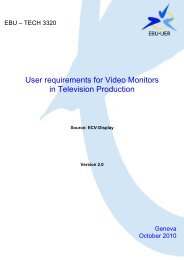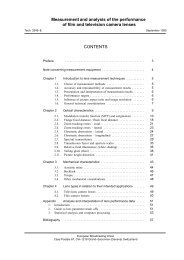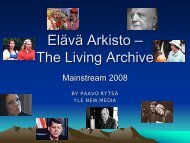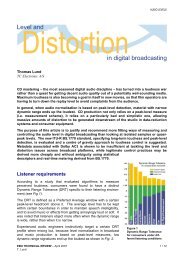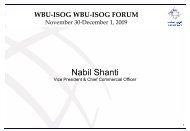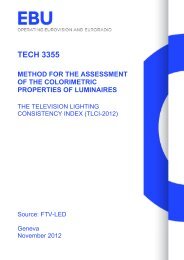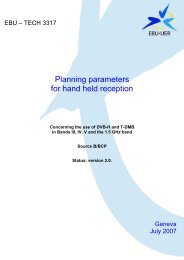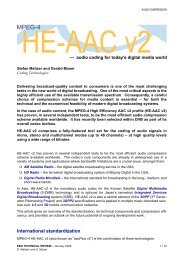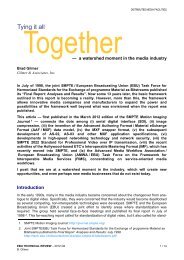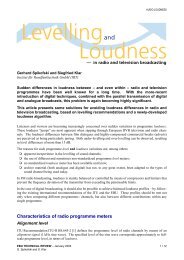Production Technology Seminar 2009 - EBU Technical
Production Technology Seminar 2009 - EBU Technical
Production Technology Seminar 2009 - EBU Technical
You also want an ePaper? Increase the reach of your titles
YUMPU automatically turns print PDFs into web optimized ePapers that Google loves.
Ethernet, power companies for power grid management…)<br />
� A few broadcast equipment vendors have built proof-of-concept systems.<br />
Using IEEE 1588 is a good path forward to synchronise digital TV plants.<br />
Digital Archives<br />
2.9 What replaces shelves: solutions for long-term storage of broadcast files<br />
Richard Wright, BBC R&D, UK<br />
The PrestoSpace project was about the 'Preservation factory' concept [5]. It had many areas of work:<br />
Digitisation, restoration, metadata, storage… [6]. But first of all, the content on our archives shelves is<br />
very much at risk: about 70% of the material is concerned with obsolescence, or decay, or fragile. 30<br />
million hours of content were specifically identified by PrestoSpace and the European project TAPE 22 .<br />
UNESCO extrapolated and estimated 200 million hours worldwide in audiovisual collections. This is why<br />
digital storage for the preservation of this material 23 (except may be some film) becomes a critical issue.<br />
So, how much digital storage would we need? In the table hereafter are the BBC weekly requirements,<br />
beside its legacy archives (650 khours video + 350 khours audio + 2M stills) [8]-[10].<br />
Summary of Storage – now<br />
(BBC production, archiving, preservation)<br />
Standard Definition Storage<br />
Requirements<br />
Summary of Storage – soon<br />
High Definition<br />
(~ SD x 4)<br />
© <strong>EBU</strong> <strong>2009</strong> / <strong>Production</strong> <strong>Technology</strong> seminar / January 27 - 29, <strong>2009</strong><br />
Reproduction prohibited without written permission of <strong>EBU</strong> TECHNICAL & <strong>EBU</strong> TRAINING<br />
Storage<br />
Requirements<br />
Raw Material, 10 khours<br />
(30 hrs/1hr drama series)<br />
1000 TB/week Raw Material 4000 TB/week<br />
Completed Material 1 khour/week 100 TB/week Completed Material 400 TB/week<br />
Archiving 300 hrs 30 TB/week Archiving 120 TB/week<br />
(Legacy) Digitisation 800 hours 80 TB/week Digitisation<br />
(Digitising old material is still in SD)<br />
80 TB/week<br />
But – only Archiving and<br />
Digitisation require permanent<br />
storage<br />
= 110 TB/week Requirement for permanent storage 200 TB/week<br />
The storage requirements for audiovisual preservation are huge - in Europe: 50 million hours (20M video,<br />
20M audio, 10M film) – worldwide: 200 million hours. Assuming following digitisation parameters: video<br />
at 200 Mbit/sec (“Rec.601”), audio at 1.4 MB/sec (CD quality), film 2k (1.5 Gbit/sec), saving 1/3 of this<br />
material brings to a total of 600 PB + 4.2 PB + 2400 PB!<br />
What is happening to storage systems?<br />
� Storage capacity goes up according to the Moore's law) [12].<br />
� Media/Device cost (e.g. cost per gigabyte) goes down: the cost reduction for storage has been faster<br />
than Moore‟s Law since mid 1990‟s.<br />
� The usage goes up.<br />
� The risk (= number of devices x capacity of the device) goes up by the square! Device reliability has<br />
increased, but the number of devices in use has greatly increased.<br />
What Archives want from storage 24 is not first storage media but they want a functionality: “everything<br />
necessary to maintain access”. We want to keep things (= persistence) and that we can use them<br />
immediately in current formats (= currency).<br />
22<br />
Training for Audiovisual Preservation in Europe<br />
http://www.tape-online.net/<br />
23<br />
http://wiki.prestospace.org/<br />
24<br />
Richard WRIGHT – "What Archives Want – the requirements for digital technology”<br />
http://tech.ebu.ch/docs/techreview/trev_308-archives.pdf<br />
35



